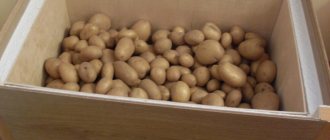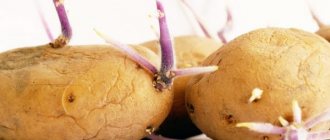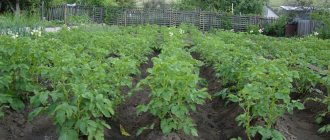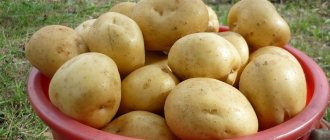Characteristics of the variety
In order to obtain high yields and unlock the full potential of the variety, it is necessary to study its main characteristics and provide the potato plants with optimal growing conditions.
Ripening period
The Nikulinsky variety, in terms of ripening, belongs to the mid-late group. The duration of the growing season of this potato is 116-120 days. Thanks to this, potato plants can successfully ripen in most of the Central regions of the Russian Federation.
To obtain two harvests per season, it is advisable to carry out cultivation in heated greenhouses using early planting (mid-April). Harvesting of the grown crop occurs from mid-September to early October.
Characteristics of tubers and description of appearance
The bushes are distinguished by their significant height of 76-80 cm. After flowering is complete and at the beginning of the formation of tubers, the bush completely lies down.
The tubers have an oval-elongated shape and a snow-white color. The peel has a mesh structure. The eyes are quite small and are located in large numbers on the tuber. Inside, a ripened tuber has white flesh that does not darken over time.
The average weight of one tuber is 76-120 g. Under optimal growing conditions, you can get tubers weighing up to 130-135 grams. Starch content – 13-21%.
Productivity
With the right growing technology, the variety is capable of producing consistently high yields in the amount of 32-45 kg per 1 m2. In conditions of industrial mechanized cultivation, this figure reaches 180-305 c/ha.
Resistance to diseases and pests
Thanks to the successful work of the breeders who created this variety, Nikulinsky potatoes have genetic protection against cancer, Alternaria, Fusarium and Verticillium. But in rainy weather there is a risk of plants being damaged by late blight.
Late blight on potato leaves
Of the pests, the most dangerous are soil pests: mole crickets and wireworms. Another serious pest is the Colorado potato beetle. In order to promptly prevent the negative impact of soil pests and late blight, a set of protective measures should be carried out in a timely manner.
For which regions are Nikulinsky potatoes recommended?
The variety is ideal for growing in the Central and North-Western regions. In the northern regions of the country, obtaining the maximum possible yields is possible by growing this variety in heated greenhouses.
Also, good yields can be obtained by cultivating potatoes in the West Siberian and Ural regions.
Features of planting and growing
Successful cultivation of a variety requires strict adherence to planting dates, taking into account specific climatic conditions. Of great importance for obtaining a healthy and abundant harvest of Nikulinsky is the correct selection and preparation of planting material.
Preparing for landing
The optimal diameter of planting material is 7-10 cm. Tubers must be smooth, free from mechanical damage, as well as signs of freezing and damage by any diseases.
It is recommended to pre-treat planting material with growth stimulants and specialized preventive agents.
Soil requirements
For growing crops, the ideal option is sandy loam soil, characterized by a sufficient degree of fertility and capable of providing root crops with high-quality aeration and drainage. Nutritious black soil is also perfect.
Dates, scheme and rules of planting
Nikulinsky is classified as a frost-resistant variety, however, it is recommended to plant it when frosts stop and the average daily temperature rises above 15°C. The exact planting date depends on the region and actual climatic conditions.
Thus, the optimal time for sowing potatoes in Siberia and the Urals is considered to be the middle and end of May, while residents of the middle zone can afford to plant prepared tubers at the end of April.
The planting depth of the Nikulinsky potato variety is from 5 to 10 cm, depending on the quality of the planting material and the regional characteristics of the soil and climate. The recommended height of the beds is 15 cm, the width between them is at least 50 cm. The optimal distance between plants is at least 20 cm.
Features of cultivation
Nikulinsky is unpretentious in care, but there are some agrotechnical features characteristic of this particular variety:
- It is recommended to use specialized preparations for the prevention and control of pests and diseases at all stages of crop cultivation. Due to this feature, the variety is not suitable for organic farming.
- To obtain maximum yield, it is recommended to regularly feed plants with mineral fertilizers.
- During planting, it is recommended to locally apply fertilizers to each planted hole (for example, ash and humus).
Compliance with the subtleties of cultivation characteristic of the variety will directly affect the quality and quantity of the harvest.
Nuances of care
The general rules for caring for plantings of the Nikulinsky variety are not much different from the algorithm for growing any other potato variety. With the only caveat that the crop requires special attention in terms of protection from pests.
As mentioned above, the variety is not suitable for organic cultivation and requires regular application of various insecticidal preparations.
Watering mode
Potatoes of the Nikulinsky variety require regular watering and do not tolerate drought well. However, its tubers will begin to rot at high humidity. Therefore, it is recommended to water the plots 3-5 times throughout the entire season, focusing on actual weather conditions.
Top dressing
Nikulinsky potatoes will delight you with their harvest if fertilizing with specialized fertilizers is carried out not only at the time of planting, but also regularly throughout the entire active growing season.
The optimal solution is to apply fertilizer during irrigation by mixing manure or chicken manure that has previously been fermented in a separate container into the water.
Weeding and hilling
Partial hilling of plants before the budding period, as well as deep and regular loosening of row spacing, will help get rid of weeds on the plot.
After hilling, it is recommended to mulch the rows of potato plots by adding rotted sawdust and humus.
Disease and pest control
Potato Nikulinsky has complex resistance to most diseases characteristic of nightshade plants.
However, it is necessary to regularly take preventive measures to avoid the nematode and Colorado potato beetle damage that is typical for this variety. Use specialized chemicals on sale, strictly following the instructions provided by the manufacturer.
14 days before harvesting root crops, the tops are removed from the beds to avoid being affected by late blight.
Advantages and disadvantages
As mentioned earlier, the variety has a whole range of positive characteristics. The most valuable of them are high yield and resistance to the most common fungal and viral diseases. It should also be noted that there are small eyes, which greatly facilitate the process of peeling and high taste.
When planted in a timely manner, Nikulinsky potatoes are able to effectively withstand severe temperature changes and quickly suppress weeds. Among the disadvantages, we can note the possibility of severe damage to the above-ground parts of the potato by the Colorado potato beetle.
Correct fit
When growing Nikulinsky potatoes, it is necessary to strictly observe the optimal planting dates, taking into account climatic conditions, prepare planting material with high quality and carry out a number of agrotechnical measures:
- For cultivation, give preference to sandy loam soils, which contain the necessary nutrients for the growth and development of the plant, and will provide them with the necessary aeration, as well as drainage;
- Choose planting material for planting that is whole, completely healthy and not frostbitten, 8-10 cm in size;
- Pre-treat the tubers using a growth stimulator and preventive agents;
- The depth of the tubers varies from 5 to 10 cm;
- During planting, fertilizers are applied locally and humus with a small amount of ash is added to the holes.
To obtain a high-quality and abundant harvest, it is necessary to follow all the subtleties of caring for Nikulinsky potatoes:
- To protect potato plantings from the spread of weeds, it is necessary to regularly loosen the rows deeply, in addition to hilling the potato bushes before the budding phase;
- Hill up only in well-moistened soil, since hilling up dry soil will cause significant drying out of the above-ground part of the potato;
- It is effective to mulch between rows on potato plantings after hilling, using humus and well-rotted sawdust;
- To protect plantings from major pests and diseases, without using strong chemicals, well-germinated and heated planting material is planted, which is pre-treated with nutrient-disinfecting solutions and natural growth stimulants;
- They feed not only when preparing the soil for planting, but also during the period of active plant growth;
- After the fertilizing procedure, abundant watering of the soil is necessary.
REFERENCE: This is due to the category of tubers, soil type and growing region.
Reviews about the variety
Anton, Armavir
The variety produces high yields, even despite strong weather changes. The tubers are large and have excellent taste. The grown crop is perfectly stored for 5-6 months. The bushes practically do not get sick, but require timely protection from the Colorado potato beetle.
Tatyana, Magnitogorsk
The Nikulinsky variety has been grown for quite a long time, and I always reap good harvests. The tubers are large, beautiful and tasty. Plants develop quickly and reach a height of up to 80 cm, thanks to which they are able to successfully choke out weeds in the inter-row spaces. The grown crop is well stored in winter.
Nikolay, Voronezh
The variety grows better when mineral and organic fertilizers are applied. He gets sick extremely rarely. The tubers are quite large and adapted for long-term storage. The taste quality of the grown crop is excellent.
Description, origin and development of the Nikulinsky variety
The Nikulinsky potato variety was obtained by crossing the Mavka potato variety and the rather popular Peresvet variety.
The originator is GNU VNII. The patent belongs to the Potato Farm named after. A. G. Lorkha.
Year of entry into the State Register: 1996.
Regions for cultivation:
- Northern;
- Northwestern;
- Central;
- Volgo-Vyatsky;
- Middle Volga;
- Ural.
Northern, Northwestern, Central, Volga-Vyatka, Middle Volga, Ural, West Siberian. It is valued for its stable high yield, independent of growing conditions, early tuberization, excellent taste, and good keeping quality. Suitable for processing into dry puree. It has poor resistance to many potato diseases.
The time from the appearance of full shoots to ripening is 115−120 days.
The plant is tall, can reach 80 cm, abundantly leafy. The main stem is erect, with many side stems. The leaves are slightly elongated, with jagged edges, and have a green color with an emerald tint. The corollas are pale red-blue-violet in color with white tips on the outside and inside.
One plant develops 8-12 tubers with an average weight of 70-135 grams, often more than 150 grams. The tubers have a round shape. The peel is light beige, with a slightly mesh structure. The pulp is cream-colored and does not darken during heat treatment and cutting. The eyes are small, uncolored, numerous. The depth is average or less.
Nikulinsky has good yield indicators. Based on the results of state tests, the marketable yield amounted to 170−294 c/ha, at the level of Lasunak standards. The best result was obtained in the Ivanovo region - 410 centners of potatoes were harvested from one hectare of cultivated area. Marketability 71−95%, shelf life 95%.
The taste of tubers is excellent. They boil well, are suitable for preparing a wide variety of dishes, are especially good for purees, boiling in their “uniform” or peeled form, baking, and are a great addition to soups. The pulp is crumbly, very pleasant consistency, moderately mealy and dry, without excessive wateriness.
When boiled, the tubers crack, but do not lose their shape, and also retain their soft creamy color, so they look very attractive when finished. The starch content in the pulp is 12.5−21.3%, at the standard level. The variety is excellent for processing into freeze-dried puree, starch and potato flour.
Nikulinsky thrives on a wide variety of soils and in different climatic conditions. However, on fertile soils rich in nutritional and mineral composition, it shows the best yield. It is stable - even under the most unfavorable weather conditions of the season, potatoes will not leave you without a harvest.
Plants are unpretentious in care, but still require proper care. One of the main agrotechnical nuances is the need to use chemicals to combat diseases and pests. Our hero is not suitable for organic farming. Experts also recommend mowing the tops two weeks before harvesting to avoid plants being damaged by late blight.
We invite you to familiarize yourself with Belim-krasim: products for whitewashing garden trees
Nikulinsky is resistant to cancer and is rarely affected by viruses. Susceptible to common scab and blackleg, prevention of these diseases is extremely important. The tops have an average susceptibility to late blight; tubers are more vulnerable to it.
Our hero has been around for quite a long time, so he has been tested by the experience of many gardeners. But opinions about its merits and demerits often differ, reaching extremes. So, for example, someone says that the taste of the tubers is simply magnificent, but someone answers that it is absolutely bland, and in general it is impossible to eat these potatoes.
Many note the stability of yield even in rainy seasons, while others refuse to grow this variety due to the fact that it begins to rot en masse in wet soil. Some are satisfied with the amount of harvest, while others are not satisfied. In short, it is very difficult to find the “golden mean” in this kaleidoscope of reviews.
But there are still some points on which the opinions of potato growers agree. Firstly, it has excellent keeping quality. Tubers are perfectly preserved until next spring and even longer, without losing their consumer and commercial qualities. Also, most gardeners note the rather large size of tuber crops, but this indicator is very dependent on the literacy of agricultural technology.
Nikulinsky's obvious disadvantage is his vulnerability to many common diseases. But it is easy to cope with this problem with timely implementation of preventive measures, as well as by observing crop rotation.
Despite the large number of conflicting reviews, our hero has long remained one of the most beloved varieties of domestic selection by gardeners. And in order to finally understand its advantages and disadvantages, you need to try to grow it on your own plot and evaluate it, so to speak, to your taste.
In addition to the originator, the following enterprises are officially engaged in the cultivation of this potato: Redkinskaya Agro-Industrial Company LLC in the Tver region, Agrocenter Korenevo LLC in the Moscow region, Green Lines-Kaluga LLC in the Kaluga region, Fat-Agro LLC in North Ossetia-Alania, LLC FH "Sedek" in the Moscow region.
Potato Nikulinsky is a mid-late table variety of domestic selection. Nikulinsky was developed by the same scientists from the All-Russian Research Institute of Potato Farming named after A.G. Lorch, who developed the Cornflower variety. Nikulinskaya was created in the early 90s. The varieties Mavka and Peresvet were used for selection. In 1996, the variety was accepted into the State Register of the Russian Federation. Like many old varieties, it is recommended for cultivation in a number of regions, namely:
- Severny.
- North-West.
- Central.
- Volga-Vyatka.
- Srednevolzhsky.
- Uralsk.
- West Siberian.
The variety has been cultivated for many years not only by summer residents from Russia, but also abroad. It is valued primarily for its good commercial qualities (excellent taste and keeping quality).
In the article you will find a detailed description of the Nikulinsky variety, photos of tubers, as well as reviews from summer residents who are familiar with it firsthand.
Year of entry into the State Register: 1996.
The harvest that potatoes provide to farmers and gardeners, in most cases, depends not only on compliance with the rules of cultivation and care, but also on a number of other factors. Sometimes high-yielding varieties can bear much less fruit than expected. Nikulinsky potatoes belong to the category of varieties that are universal in terms of growing conditions and are distinguished by their stable yield.
This variety of vegetable was bred in the early 90s by breeders of the domestic potato production named after. A. G. Lorkha by crossing the Peresvet and Mavka varieties. The new species was included in the state register of breeding successes of the Russian Federation in 1996 based on data from such regions of the Russian Federation as: West Siberian, Middle Volga, Northern, Ural, Volga-Vyatka, Central and Northwestern.
Nikulinsky is a variety of medium and late ripeness; final ripening after potato germination will take about 4 months. The tubers themselves form early; one bush is capable of growing from 8 to 12 fruits, whose average weight varies from 70 to 150 g.
Nikulinsky is one of the domestic varieties that were bred for resistance to the Colorado potato beetle. The result is a variety that is unattractive to Colorado. However, it still attracts other pests, in particular the nematode.
This species is slightly susceptible to leaf blight. It is not affected by viruses such as verticillium, fusarium, and alternaria and is immune to the Y-virus and potato cancer.
The most common diseases of the Nikulinsky variety:
- common scab;
- black leg;
- late blight of root crops.
Nikulinsky is distinguished by a large number of large leaves, jagged along the edges and having an oblong shape, with a rich green color. It gains about 80 cm in height. The bushes grow straight, producing numerous branches.
During flowering, the plants form violet-blue-red inflorescences with white ends. The round fruits are strewn with small eyes and have a slightly mesh skin of a light beige color.
Taste qualities
Many gourmets value Nikulinsky potatoes for their excellent taste and the breadth of their uses.
In addition to being used in cooking for preparing country potatoes, liquid and fried dishes, potato balls, casseroles, mashed potatoes and other dishes, it is also in demand in the food industry. It is used to produce chips, granules, starch and flour.
The main conditions for a good harvest are timely preparation for planting and implementation of agricultural technology procedures taking into account the necessary standards.
Planting a crop
To obtain fast and healthy seedlings, you need to properly prepare the seed material. To do this, at the end of March, the tubers are taken out of the basement and sorted by hand, separating rotten and damaged specimens.
After sorting, the tubers are placed in boxes in 1-2 layers and placed in a room for germination. It is important that in this room the air temperature must be constantly maintained at + 20 + 22 degrees Celsius.
When sprouts 2-4 cm long appear, the planting material can be planted in a permanent growing location. A few days before planting, it is advisable to treat the tubers with a fungicidal preparation to destroy the infectious onset of dangerous fungal diseases. Learn more about how to prepare potatoes for planting.
For cultivation, a fertile area of soil with deep groundwater and good lighting is selected. We should not forget about the correct choice of predecessor. So the best of them are peas, soybeans, and beans.
Planting of tubers should be carried out in holes or furrows no more than 5-6 cm deep. Planting tubers too deeply may subsequently result in problems with digging up the grown crop and a late start to growth.
It is also important to plant potatoes in a timely manner. Do this when the soil at a depth of 10 cm warms up to +10 +12 degrees. This temperature regime in the soil develops in the first ten days of May. The optimal planting pattern for this variety is 25-30 x 80-90 cm.
Useful article:
How to plant potatoes correctly
Description of the potato variety Nikulinsky
Potato Nikulinsky is a mid-late table variety of domestic selection. The development of Nikulinsky was carried out by the same scientists from the Federal State Budgetary Scientific Institution "All-Russian Research Institute of Potato Farming named after A.G. Lorch", who developed the Cornflower variety.
Nikulinskaya was created in the early 90s. The Mavka and Peresvet varieties were used for selection. In 1996, the variety was accepted into the State Register of the Russian Federation.
Like many old varieties, it is recommended for cultivation in a number of regions, namely:
- Severny.
- North-West.
- Central.
- Volga-Vyatka.
- Srednevolzhsky.
- Uralsk.
- West Siberian.
The variety has been cultivated for many years not only by summer residents from Russia, but also abroad. It is valued primarily for its good commercial qualities (excellent taste and keeping quality).
In the article you will find a detailed description of the Nikulinsky variety, photos of tubers, as well as reviews from summer residents who are familiar with it firsthand.
Planting a crop
The key to success in growing potatoes is to comply with planting dates and take into account climatic conditions. Also, the better the quality of planting material, the greater the likelihood of obtaining a good harvest.
Basic planting rules that must be followed when growing potatoes:
- The ideal soil for growing this crop is sandy loam soil. But many summer residents have quite heavy soil, which is why they have to resort to some agrotechnical tricks. Typically, potatoes are planted to a depth of 7-10 cm. If the soil is heavy, then potatoes cannot be placed deeper than 5 cm. Also, heavy soil is compensated by applying fertilizers, not only during soil preparation (in the fall), but also immediately before planting the tuber (a handful of wood ash is added to each hole).
- For planting, only high-quality seed material should be selected. These should be tubers of medium size and weight (about 8-10 cm and weighing up to 80 g). In addition, their surface should not contain any defects (rot, growths, insect holes, cracks, etc.).
- When planting, it is recommended to adhere to the 70x35(40) cm pattern. Thanks to the large distance between the rows, good aeration and illumination of the bushes will be ensured. Also, the procedure for hilling bushes will be significantly simplified, since neighboring rows will not interfere.
Rules of care
Nikulinsky, like most potato varieties, is not particularly demanding in terms of care. However, if all agrotechnical rules are followed, the chance of getting a high-quality harvest is almost 100%.
Basic rules of care:
- Do not allow the area to be contaminated with weeds. This is especially true during the period when potatoes are just beginning to develop. Weeds significantly inhibit its development.
- Be sure to hill up the rows. Hilling can increase yield by 20-30% due to the formation of new stolons, on which tubers are born. In addition, in addition to this function, hilling allows you to loosen the soil, saturating it with oxygen, and remove the same weeds.
- Be sure to water the potatoes. Potatoes are a strong crop that can survive without watering (purely on natural precipitation). However, then the tubers will not be as juicy and large. Potatoes need to be watered at least three times: after the tops appear, during flowering and before it ends. It is not recommended to water the bushes after they have bloomed, as there is a risk of contracting late blight, which is active during this period of time.
- Loosen the soil. Ideally, it is necessary to loosen the soil after each watering or rain. Tubers that do not receive enough oxygen and grow in hard soil develop very poorly. In addition, due to the density of the soil, they often become deformed, losing their attractive presentation.
We recommend reading: “Description of the Gornyak potato variety”
The final formation of root crops begins after the tops dry. It is during this period that the tubers form a dense shell and accumulate starch. Many gardeners mow the tops immediately after flowering to promote faster ripening of the tubers.
However, it has already been proven that this procedure reduces yields by 15-20%. Instead, it is necessary to mow the tops 7-10 days (maximum) before the planned harvest. Then the yield will remain at the same level, and the tubers will be better prepared for long-term storage.
The ideal temperature for storing crops is +2-3 degrees Celsius.
Rules of care
In addition to correct and timely planting, it is necessary to organize and fully carry out all the necessary measures for caring for potatoes. This is the only way to get a significant harvest.
So, after the emergence of friendly shoots, the soil surface should be regularly loosened to a depth of 2-3 cm in order to timely seal off moisture and destroy unwanted weeds.
Despite the fact that the variety can successfully tolerate drought, to obtain the maximum possible yield, the plants should be watered at least once a week in a volume of 10-12 liters per 1 m2.
For better absorption of moisture by plants, water in the evening.
An important agricultural practice is the double hilling of potato bushes. The first hilling is carried out when the shoots reach a height of 15-20 cm. The second hilling should be performed when the bushes grow to a height of 25 cm. It is important that during the hilling process large soil blocks do not form.
Many people also carry out intermediate hilling of potatoes; there is an article on this topic on the website.
For the rapid development of Nikulinsky potato bushes and the formation of large tubers, four feedings should be carried out.
- The first is performed when seedlings appear using a solution of ammonium nitrate (13-15 g per 12 liters of water). The solution consumption rate is 3-5 l. per 1 m2.
- The second feeding is carried out after 3 weeks using a solution of liquid mullein (1:12). 3-4 liters are consumed per 1 m2. prepared solution.
- The third feeding is carried out a few days before flowering. A liquid complex fertilizer is used, which is evenly applied using a sprayer to the leaf surface of potato plants. The best in their class are the Vympel liquid-commodity fluids (12-14 ml per 9-10 liters of water) and Energen Aqua (11-12 ml per 10-12 liters of water).
- The last fourth fertilizing should be carried out 2 weeks after flowering. During this period, it is best to use a solution of fermented manure. It is prepared by dissolving 1 liter. litter of 12 liters. water. The application rate for this solution is 4-5 liters. per 1 m2.
Peculiarities
Many farmers and experts from the West rate the taste of this variety at 4.8 points out of 5 possible. As a result of the large amount of starch in the tubers, they do not darken or become soft during the cooking process.
Growing seedlings
The selected planting material is laid out in one layer in wooden boxes and covered with a mixture of peat and soil. To obtain seedlings, the boxes are covered with polyethylene and placed in a sunny place. Optimal conditions for storage will be a temperature within 12-14 0 C. The appearance of sprouts can be noticed after 2-3 weeks.
You can plant seedlings in early May, when the ground is sufficiently warmed up and the risk of frost has completely disappeared.
When planting potatoes, the distance between the rows must be left 60-70 cm, which will provide the bushes with good air exchange and illumination, and will also simplify the process of hilling and processing the planting.
It is recommended to leave a distance of 20-25 cm between each bush. To improve the microclimate and retain moisture at the stage of planting potatoes, you can mulch them.
To get a good harvest of Granada potatoes, you must follow the following care rules.
- Regularly hill up the bushes, which promotes the proper development of underground shoots. In addition, it allows you to insulate weak and tender young shoots.
- The variety can easily tolerate dry weather. If spring assumes regular precipitation, then watering the potatoes is not required until the first flowers appear. In the absence of rain, it is advisable to moisten the soil every 1.5 weeks.
- It is good to use chicken manure as fertilizers, as well as a composition of superphosphate, urea and sulfate. For the first time, fertilizing is applied a month after planting the seedlings.
The variety is intended for planting in open soil. In cold regions, the subspecies can be planted in all types of greenhouses. Sowing is done in early May. Recommended planting pattern: 35x70 cm. No more than 47,000 bushes should be placed per 1 hectare. The sowing depth should not exceed 8-10 cm.
Planting material should be placed after perennial grasses, legumes and grain crops. The chosen place should be well lit.
Planting potatoes near groundwater is not allowed. Otherwise, the root system will not be able to actively develop, and the fruits will begin to rot. The variety responds well to fertilizing. You can use mineral, nitrogen or potassium fertilizers. When applied correctly, productivity increases.
Read more about what to feed plants, when and how to apply fertilizers, how to do this when planting and what are the best fertilizers.
Another important stage is hilling. During the growing season, hilling is performed at least twice. The first is performed when the bushes grow 15-17 cm, the second - before flowering.
Soil taken between the rows should be raked to the base of the plant. This procedure prevents the bushes from falling apart and protects them from bad weather. Thanks to hilling, underground stems appear in large numbers. The procedure can be performed either manually or using a walk-behind tractor. Mulching should be used to control weeds.
Characteristic features of "Granada":
- Grows on any soil, but maximizes its potential on light, well-fertilized sandstones;
- Adapts to different climatic conditions. Demonstrates average yields even during drought;
- Due to its marketable appearance, transportability and preservation, the variety is suitable for both home and commercial farming and trade.
Diseases and pests
In very rainy weather, Nikulinsky potatoes can be massively damaged by late blight. To combat this disease, it is necessary to observe crop rotation with a return to the original place of cultivation no earlier than after four years.
Also, before flowering begins, you need to carry out two preventive sprays of potato leaves with Ridomil Gold. It is very important to perform two more sprays with the above-mentioned drug at an interval of 6-7 days at the first signs of the disease.
To prevent damage to tubers by soil pests, you should also follow the recommended crop rotation and use the chemical Vofatox, the granules of which are embedded in the soil between rows to a depth of 2-4 cm. If you notice yellow caterpillar-shaped larvae in the field, we strongly recommend reading the article on how to get rid of from wireworm in potatoes.
Click beetle and its larvae - Wireworm
Against the Colorado potato beetle, it is necessary to promptly use drugs from the insecticidal group: Metafos, Karbofos, Bombardir. It is very important not to be late with treatment, since this pest has increased gluttony and with the massive appearance of young beetles, the above-ground part of the potato can be completely destroyed in a few days.
History of the variety's creation
The Nikulinsky potato appeared not so long ago, it was bred by breeders of the State Scientific Institution All-Russian Research Institute of Potato Farming named after. A. G. Lorkha. The parent pair of varieties, Mavka and Peresvet, transferred their best properties to the new variety. Its name is associated with the name of the artist Yuri Nikulin.
Memphis Potatoes
The fact is that scientists from the Potato Research Institute, which was located in the village. Korenevo, were invited to the artist’s anniversary. He celebrated 70 years. The breeders knew that the hero of the day liked to grow vegetables with his own hands, so they decided to give him several tubers of new varietal potatoes.
Interesting! The variety named after the actor was entered into the State Register of the Russian Federation under number 15-078-99 F. It became as popular among gardeners and vegetable growers as the person in whose honor it was named.
Harvest and storage
It is necessary to harvest when the tops are completely dry and the skin of the tubers has become significantly coarser.
For harvesting, you can use both manual equipment - shovels and garden forks, and mechanization - a tractor with a potato digger.
In the process of digging up the grown crop, you must try not to damage the tubers. This is very important for further successful storage.
The dug up tubers are transferred under a canopy and laid out in one layer to dry. After this, the tubers are sorted by hand and sorted by size. After processing and cleaning, the tubers are placed in wicker baskets or boxes with holes in the bottom and walls.
In order for the grown crop to be stored for a long time without losing its original quality, it is necessary to create the necessary conditions for this. Therefore, the room where the crop will be stored must have a constant air temperature from + 1 to +3 degrees Celsius and air humidity not higher than 60%.
It is also important that the ventilation system works effectively in such a room.
During storage, it is necessary to monitor the condition of the tubers once a week and if an unpleasant odor is detected, manual sorting of rotten potatoes should be carried out.
Good to know:
Rules for storing potato crops
How to harvest and store crops
When the tubers are fully ripe for harvest, the above-ground part of the bush begins to dry out. It is removed 2 weeks before harvesting the potatoes. In order to ensure good preservation of root crops, they are collected on warm, dry days, discarding sick and damaged ones. After drying the potatoes in a non-humid room, they are stored. Long-term storage is ensured at a temperature of 2 to 3 °C.
Storage features and keeping quality of the Nikulinsky variety
The collected fruits of this variety are stored in trenches, cellars, pits and basements, using containers, bags, boxes and nets.
Nikulinsky potatoes have excellent keeping quality
Within the living area, storage rooms, balconies, loggias and refrigerators are suitable; it is recommended to avoid humidity and maintain temperature conditions. Nikulinskaya potatoes have good marketability, ranging from 71 to 95%. The shelf life of this variety is 95%.
Description of the plant, tubers
The variety was obtained by breeders of the State Scientific Institution “Potato Farm named after. A.G. Lorch" in 1994. “Luck” is characterized by a short ripening period and high yield.
The plant forms a densely leafy bush, the height of which reaches 40 cm. The flowers are white. Medium sized bushes.
Luck tubers have a pleasant soft yellow color, varying to brown, with white flesh. The fruits of the variety have a standard oval or round shape with a small number of eyes. The peel is extremely thin, this will greatly facilitate the process of cleaning and cooking, and the white pulp becomes yellowish during the boiling process. The taste of the variety has received many positive reviews.
Yield indicators and characteristics of the variety
| Weight of 1 tuber “Luck”, gr. | Number of tubers per plant | Starch content, % | Commercial products, % | Productivity per plant, kg |
| 120-160 | 10-12 | ≈ 13 | ≈ 90 | 1,5-1,7 |
“Udacha” is a heat-resistant, unpretentious variety that grows on different types of soil, but is quite sensitive to agricultural cultivation techniques.
Germination
To speed up the harvest, the “Lucky” tubers need to be sprouted. Germination begins in the first ten days of February according to the principle: the earlier the potatoes sprout, the earlier the harvest begins.
When planning an early harvest date for potatoes grown to incomplete maturity, you should not select small tubers with a diameter of less than 5 cm; such plants grow later compared to those grown from larger tubers.
It will take 6-8 weeks to get a high quality harvest. For germination, the tubers are scattered into boxes. 15-17 kg of potatoes are poured into a box measuring 40-60 cm. At this stage, you can carry out pre-planting treatment against diseases and pests using Prestige Forte Prestige Forte 370 FS. 60 ml of the drug is measured per 100 kg of tubers per dose of water 1500-2000 ml. The tubers are soaked in the preparation.
In the room where boxes with potatoes are placed for germination, it should be 12-15 degrees C, humidity 90%, light (natural or artificial) - 10 hours a day. It is advisable to move the boxes every 2 weeks to ensure optimal light for all the potatoes.
The optimal date for planting Udacha tubers is in the second to third ten days of April, when the soil temperature at a depth of 10 cm is about 10 °C. If the variety is grown under agrotextiles, seed potatoes can be planted earlier, at soil temperatures above 5 °C.
Long-term exploitation of the soil under one crop contributes to the accumulation of diseases and pests. As gardeners note, the “Udacha” variety is prone to degeneration - after a few years, the seed needs to be renewed.
The planting depth should not be large, as this will slow down the growth of the plant. Potatoes take quite a long time to rise – 3-5 weeks. Planting depth is an important parameter that determines the quality of the crop. When planting, you should pay attention to the size of the fruit. You can use whole or cut tubers. For convenience, the tubers should be sorted.
Tubers are planted depending on size in beds:
- large and medium - to a depth of 9 cm;
- shallow - to a depth of 5 cm.
It is optimal to grow tubers at a distance of more than 20 cm. The distance between the beds is 35-40 cm.
For successful cultivation of “Luck”, nutritious soil is required. Potatoes don't like manure. It can be used provided that the tubers are planted 2-3 years after the application of manure. When potatoes are planted 1 year after applying manure, the tubers become less tasty and are poorly stored. It is assumed that the optimal dose of manure per 1 hectare is 25 tons - it adds to the soil on average:
- 125 kg nitrogen,
- 75 kg phosphorus,
- 150 kg potassium.
We suggest you familiarize yourself with a remedy for grass to prevent it from growing on garden paths
The optimal solution would be to combine organic fertilizer with mineral fertilizer, which will help increase the yield of the variety. The choice of fertilizer doses should be based on an analysis of soil fertility based on nutrients.
If there is no soil analysis, the dose of fertilizer is determined in accordance with the ratio N:P:K = 1:1:1.5-2. For early potatoes, you should not use too large doses of nitrogen fertilizers, since they cause excessive growth of above-ground parts of plants, delay the formation of tubers, and reduce yield.
It is important to fertilize while loosening the soil carefully: the leaves of the plant must remain clean, the dosage of the amount of fertilizer must be observed, otherwise “holes” (hollows) may form in large potato fruits. The amount of additives is calculated per 1 m²:
- a bucket of humus, a glass of ash, 2 tablespoons of nitrophoska;
- Having plowed the soil with green manure, add a 1:1 mixture of ammonium nitrate and potassium sulfate.
At the very beginning of the growing season, potatoes are very sensitive to competition from weeds. Weeds can also significantly complicate harvesting and reduce the quality of tubers. Therefore, it is necessary to regularly remove them by weeding.
Luck potatoes can be affected by the Colorado potato beetle. Some tips for eliminating the pest.
- Adding ash to planting holes.
- Dusting potato plants with compositions of gypsum and corn flour.
- Early spraying with a mixture of soap and ash.
- Chemicals.
The first mass raid of the Colorado potato beetle occurs at the turn of June and July. Effective control of it requires 1 to 3 sprayings. If the plantings are small, it is better to use traditional methods: collect the beetle, crush its eggs on the underside of the leaves manually.
Harvesting
Approximately 2 months after planting, the tops of the plants will turn yellow and fall off. Now you need to harvest the crop for further storage and consumption. Having lifted the tops, the potatoes are dug up and sorted. Unusable - approximately 5-7% - is removed, the rest is put in the shade to dry.
Harvesting should be done in hot, dry weather. The soil temperature should not be below 10 ° C, humidity should not exceed 15%. The harvest date for early potatoes is from the third decade of June to the end of July, depending on the planting date and climatic conditions.
When the crop is dry, it can be transported to the basement. The temperature should be maintained at about 3 degrees, then the potatoes will remain intact until spring and will not lose their taste.
Characteristic
Nikulinsky potatoes are used not only to create various dishes, but also to prepare dry semi-finished products. Due to the fairly high starch content in the vegetable (from 12 to 21%), it is also suitable for making starch mass.
Potatoes "Nikulinsky" are cultivated from two well-known varieties: "Mavka" and "Peresvet". Let's consider the description of this type.
- The plant is erect, tall (according to some sources, it can reach a height of 80 cm), has a large number of leaves, and during the flowering period its flowers are painted in pale tones of red and purple. Flowering lasts quite a long time, the flowers themselves are small and there are many of them on each bush. The leaves of the plant are large, with a clear outline.
- The fruits are round, covered with a mesh skin of light beige or yellowish color. The “eyes” of the fruit are rather small, colorless and shallowly located. The root vegetable is white when cut and does not change color when cooked.
- There are from 8 to 12 potatoes per bush, each weighing from 70 to 120 grams. The average estimated fertility in the presence of good soil ranges from 170 to 300 (occasionally above 400) centners per hectare of sown area.
- The variety has medium late germination, that is, the plant ripens in an average of four months.
- The Nikulinsky variety has increased resistance to potato cancer and Y-virus. It fights well and resists the fungus Phytophthora infestans, that is, it is less susceptible to late blight. The plant is noted to have average resistance to common scab, Alternaria blight (potato dry spot), and a fungal potato disease, rhizoctonia. This potato variety is resistant to weather conditions. Tolerates drought and even hail perfectly.
- Potatoes keep well and for a long time.
Among the negative properties of the variety, one can note the risk of damage by potato nematode and insufficient resistance to the Colorado potato beetle.
This type of potato can most often be found in the central regions of Russia, in the Volga region. It can often be observed at dachas in the Moscow region, in the Yaroslavl, Ivanovo, Vladimir, Perm, and Nizhny Novgorod regions. You can meet him in the Altai and Krasnodar regions. Suitable for cultivation on soils of the Urals and Siberia. It grows in various countries, such as Belarus, Kazakhstan, India, China, Ukraine, Moldova.









